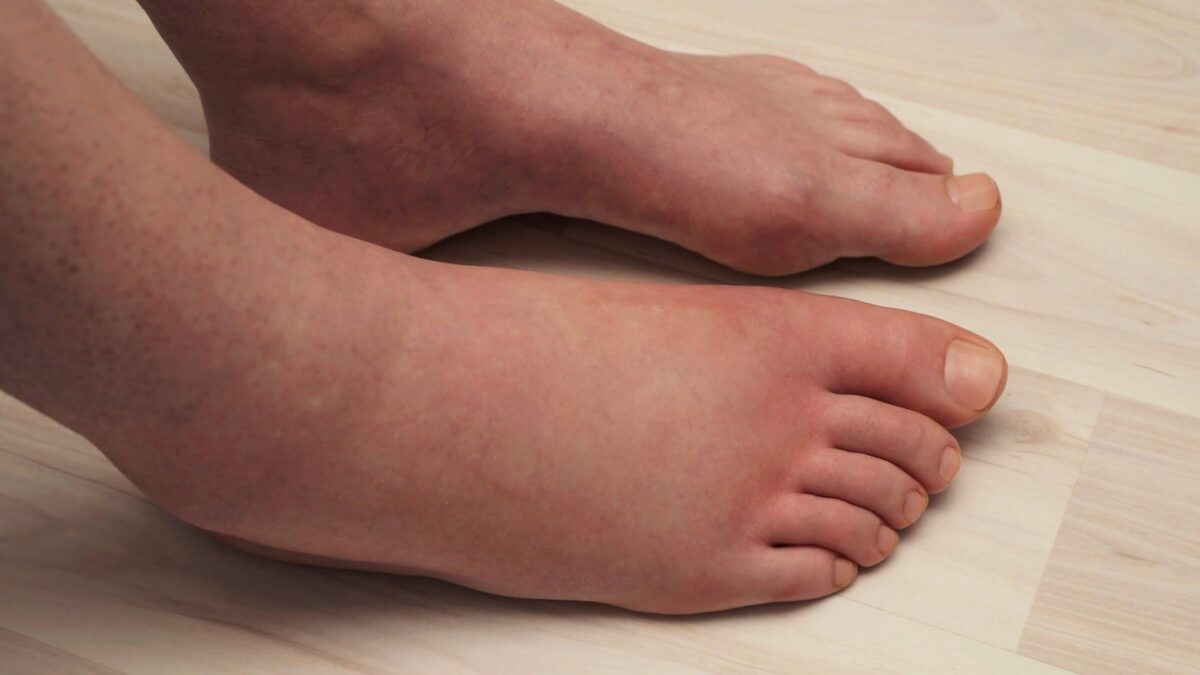Overview
Edema, commonly referred to as swelling, occurs when excess fluid leaks from capillaries and accumulates in the tissues. It is important to note that edema is not a disease but rather a symptom of underlying conditions or suboptimal physical states.
Edema often affects the legs, ankles, and feet, though it can manifest throughout the body. For instance, in cases of heart disease or pneumonia, fluid may accumulate in the lungs, a condition known as pulmonary edema.
The duration of edema depends on its cause. While some cases are temporary, others may persist long-term due to chronic illnesses or ongoing medical issues. Edema is relatively common, especially in older adults and individuals with underlying health conditions. However, anyone can experience it depending on the circumstances.
Table of Contents
Possible Causes of Edema

Edema can result from several factors, including poor lifestyle habits, temporary physical conditions, medication side effects, or underlying health issues. Here are the key causes:
- Poor lifestyle habits. Consuming salty foods excessively and lack of exercise can lead to fluid retention, resulting in edema.
- Dependent edema. This occurs due to gravity and natural blood flow to the legs, ankles, and feet. It typically happens when a person remains seated or standing in one position for extended periods without movement.
- Pregnancy. Pregnant women often experience swelling due to increased fluid levels required to nourish both the mother and the baby. Additionally, the growing fetus may compress veins, reducing blood flow to the legs and causing fluid buildup.
- Menstrual cycle. Some women develop edema before their monthly period due to hormonal changes that affect fluid retention.
- Medications. Several medications may cause fluid retention, such as:
- Steroids
- Non-steroidal anti-inflammatory drugs (NSAIDs) like ibuprofen, naproxen, and mefenamic acid
- Medications for neuropathic pain
- Thiazolidinedione (used for diabetes)
- Antihypertensive medications
- Estrogen treatments
- Medical conditions. Many illnesses can lead to edema, including heart disease, kidney disease, liver conditions, and lymphatic blockages. These diseases impair fluid balance, leading to accumulation in various parts of the body.
Understanding these potential causes is vital for addressing edema effectively. Identifying and managing the underlying reason often resolves the symptom.
Disorders Associated With Edema

Edema is often linked to various medical conditions that disrupt the balance of fluid in the body. Understanding these disorders can provide insight into the potential causes of swelling and how it can be managed. Below are some of the most common disorders associated with edema:
- Heart failure. In heart failure, the heart’s ability to pump blood effectively is reduced, leading to fluid buildup in the lungs (pulmonary edema) or extremities, such as the legs and feet. Treatment typically involves medications like diuretics to reduce fluid and improve heart function.
- Kidney disease. Damaged kidneys may fail to regulate fluid and sodium properly, causing water retention and swelling, particularly around the eyes, hands, and feet. Treatments often include dietary adjustments, medications, or dialysis in severe cases.
- Liver disease. Conditions like cirrhosis impair liver function, leading to fluid retention in the abdomen (ascites) or legs. Management focuses on diuretics, dietary changes, or treating the underlying liver condition.
- Lymphedema. This condition occurs when the lymphatic system is blocked or damaged, causing fluid to accumulate, typically in the arms or legs. Compression therapy, exercises, and lymphatic drainage are common treatments.
- Deep vein thrombosis (DVT). A blood clot in a deep vein can obstruct blood flow, resulting in localized swelling in one leg. Treatment involves anticoagulant medications to dissolve the clot and prevent recurrence.
- Hypothyroidism. An underactive thyroid can cause fluid retention and swelling, especially in the face and extremities. Treating the thyroid imbalance with medication can resolve the edema.
- Allergic reactions. Severe allergic reactions, such as angioedema, can lead to sudden swelling in the face, lips, and throat. Immediate medical attention and antihistamines or epinephrine are often required.
- Infections. Skin infections, such as cellulitis, can cause localized swelling, redness, and tenderness. Antibiotics are typically used to treat the infection and reduce swelling.
Addressing edema effectively often involves diagnosing and managing the underlying disorder. Prompt medical evaluation is crucial, especially if the swelling is sudden, severe, or accompanied by other symptoms.
When to See a Doctor
Edema may sometimes resolve on its own, especially if it is caused by minor lifestyle factors. However, there are instances when professional medical advice is essential. Seek immediate medical attention if:
- The swelling appears suddenly or is severe.
- Edema is accompanied by shortness of breath, chest pain, or difficulty breathing.
- You experience swelling on only one side of the body, especially the leg, which could indicate a blood clot.
- There is redness, warmth, or tenderness in the swollen area, as this may suggest an infection.
- The swelling worsens over time or does not improve despite lifestyle changes.
What Type of Doctor to Seek
For evaluation and management of edema, you may consult the following specialists:
- Primary care physician. They are often the first point of contact and can assess the underlying cause of edema or refer you to a specialist.
- Cardiologist. Consult a heart specialist if the edema is related to heart issues such as heart failure.
- Nephrologist. A kidney specialist can help if kidney disease is suspected as the cause.
- Endocrinologist. If thyroid problems or hormonal imbalances are contributing factors, an endocrinologist can help.
- Vascular specialist. If the swelling involves blocked veins or lymphatic system issues, a vascular expert is recommended.
What to Expect from Your First Doctor Visit
During your first visit, the doctor will perform the following:
- Medical history review. They will ask about your symptoms, lifestyle, and any underlying health conditions. Be prepared to discuss your diet, medications, and any recent injuries.
- Physical examination. The doctor will examine the swollen area for signs of fluid retention, tenderness, or other abnormalities.
- Diagnostic tests. Based on the initial assessment, you may undergo blood tests, urine tests, imaging studies (like ultrasound or X-rays), or an electrocardiogram (ECG) to determine the underlying cause.
Addressing the symptom early can help identify potentially serious conditions and improve outcomes, so don’t hesitate to seek professional advice if you notice concerning signs of edema.
What to Expect From Your First Doctor Visit
When visiting a doctor for edema, your initial consultation will involve a thorough assessment to determine the underlying cause. Here is what you can typically expect:
- Medical history review. The doctor will ask about your symptoms, when they began, and whether they are constant or fluctuate. They will also inquire about your overall health, medications you take, dietary habits, physical activity levels, and any recent injuries or illnesses.
- Physical examination. A detailed examination of the swollen area will be conducted. The doctor may check for signs of fluid retention, redness, warmth, tenderness, or other abnormalities that could indicate infection, inflammation, or an underlying condition.
- Diagnostic testing. Depending on your symptoms, you may undergo further tests, such as:
- Blood tests to assess kidney, liver, and heart function.
- Urine tests to check for protein or abnormalities suggesting kidney issues.
- Imaging studies like X-rays, ultrasounds, or CT scans to evaluate fluid buildup and related organ function.
- Electrocardiogram (ECG) to assess heart health if a cardiac issue is suspected.
- Discussion of findings. The doctor will explain the results of the initial examination and tests (if available) and provide insights into possible causes of your edema.
- Treatment plan. Based on the findings, the doctor will suggest a course of action. This may include lifestyle modifications, medications like diuretics, or referrals to specialists if a more complex condition is detected.
Understanding what to expect during your first visit can help you feel more prepared and proactive about addressing your symptoms.
Edema FAQs
Edema is a common symptom that many people experience at some point in their lives. It occurs when excess fluid accumulates in the body’s tissues, leading to swelling. While it is not a disease, it can be a sign of underlying health conditions that may require attention. Below are answers to frequently asked questions about edema to help you better understand this condition.
- What is edema? Edema is swelling caused by the accumulation of excess fluid in the body’s tissues, commonly affecting the legs, ankles, feet, or other parts of the body.
- Is edema a disease? No, edema is not a disease but a symptom that can indicate an underlying medical condition or physical imbalance.
- What causes edema? Edema can result from poor lifestyle habits, pregnancy, medications, gravity, or medical conditions such as heart, kidney, or liver disease.
- Can edema resolve on its own? Yes, mild cases of edema, particularly those caused by lifestyle factors or temporary conditions, may resolve without treatment. However, persistent or severe edema requires medical attention.
- When should I see a doctor for edema? Seek medical advice if the swelling is sudden, severe, or accompanied by symptoms like pain, redness, shortness of breath, or chest pain.
- What tests are done to diagnose edema? Diagnosis may involve physical exams, blood and urine tests, imaging studies (e.g., ultrasound or X-ray), or an electrocardiogram (ECG) to identify the underlying cause.
- What are common treatments for edema? Treatments include lifestyle changes (reducing salt intake, elevating legs), diuretics (to remove excess fluid), and managing the underlying condition.
- Can edema be prevented? Preventive measures include staying active, avoiding prolonged sitting or standing, maintaining a healthy diet low in sodium, and managing chronic conditions like hypertension or diabetes.
- Does pregnancy always cause edema? Not always, but mild swelling in the legs and feet is common due to increased fluid levels and pressure on veins during pregnancy.
- Is edema life-threatening? While mild edema is usually not dangerous, it can signal serious conditions like heart failure, blood clots, or organ damage. Immediate medical attention is required for such cases.
By understanding the causes, symptoms, and treatments of edema, you can take proactive steps to manage or prevent it effectively. If you notice persistent or severe swelling, consult a healthcare professional to determine the best course of action and address any underlying health issues.


